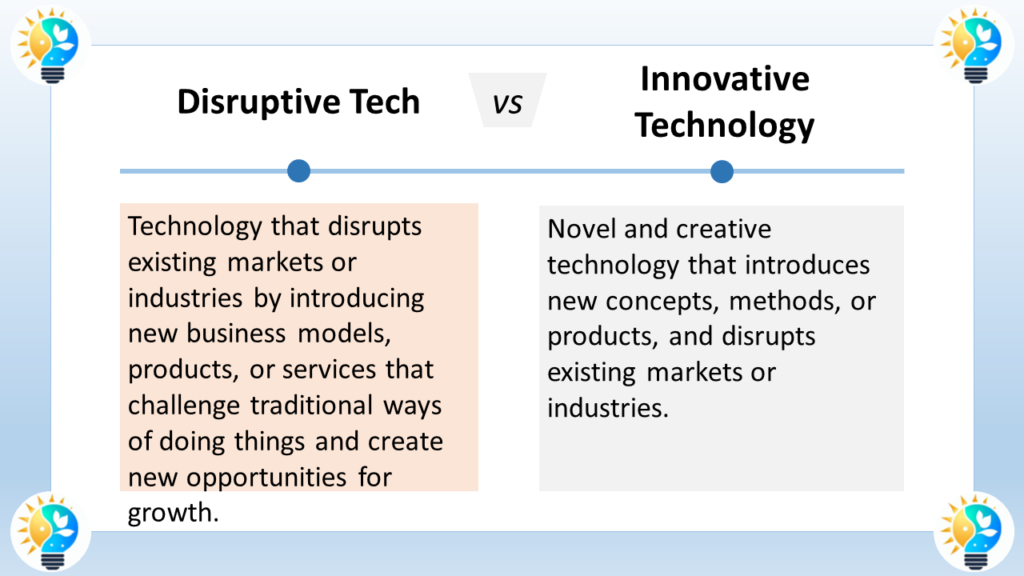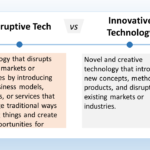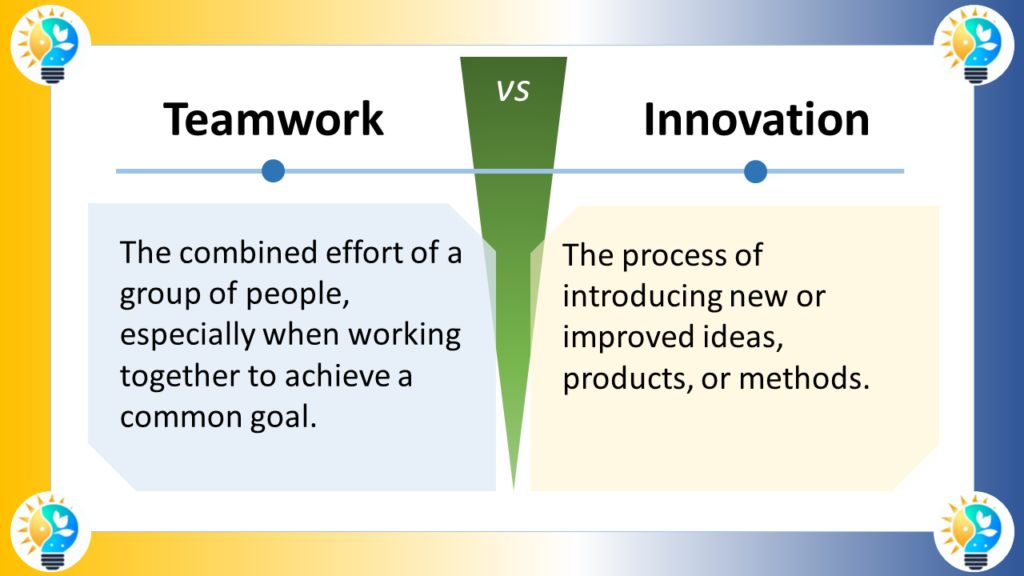Disruptive and innovative technologies both shake up markets, but while disruptive tech revolutionizes industries, innovative technology explores novel avenues, sometimes revolutionizing industries in the process.

In the realm of technological development and business strategy, Innovative Technology and Disruptive Technology are terms that are often mentioned in discussions about progress and market dynamics. Although they share some similarities, they are distinct in their nature and the impact they have on industries and consumer behavior.
Definitions
Defining Innovative Technology
Innovative Technology refers to the creation or use of new ideas, devices, or methods that bring about a significant change or improvement. It is not solely confined to the invention of new products but also encompasses novel applications of existing technologies or the development of new processes that enhance performance or user experience.
Characteristics of Innovative Technology
- Novelty: Introduces something new or applies existing concepts in new ways.
- Improvement: Aims to enhance efficiency, effectiveness, or other aspects of current technology or processes.
- Adoption: Can be widely adopted but doesn’t necessarily lead to dramatic market shifts.
Defining Disruptive Technology
Disruptive Technology, on the other hand, is a term popularized by Clayton M. Christensen, describing a new technology that unexpectedly displaces an established one, fundamentally changing an industry or creating a new market.
Characteristics of Disruptive Technology
- Market Impact: It significantly alters or creates markets and value networks.
- Accessibility: Often starts by targeting overlooked segments or offering simpler, more affordable options.
- Growth: Typically grows in an ecosystem until it eventually displaces established competitors.
Exploring a Variety of Synonyms for Innovative Technology
- Advanced Technology
- Cutting-Edge Innovations
- Cutting-Edge Breakthroughs
- Disruptive Tech
- Emerging Technologies
- Forward-Looking Tech
- Futuristic Innovations
- Groundbreaking Developments
- High-Tech Breakthroughs
- Innovative Breakthroughs
- Inventive Solutions
- Leading-Edge Advancements
- Modern Technological Breakthroughs
- Progressive Advancements
- Next-Generation Technology
- Novel Tech
- Revolutionary Tech
- State-of-the-Art Solutions
- State-of-the-Art Innovations
- Trailblazing Innovations
- Visionary Tech

Innovation is considered as a driving force in progress.
It includes the introduction of novel ideas, methods, or products that bring positive change and advancement.
For more information about innovations, check our glossary
Innovative vs. Disruptive: Relationship and Relevance
Every disruptive technology starts as an innovation, but not all innovations become disruptive. Innovative technologies may lead to incremental improvements and could be adopted widely without necessarily causing disruption. Disruptive technologies begin as innovations but go on to redefine industries or consumer behaviors, often leading to the downfall of companies that fail to adapt quickly enough.
The relevance of both is undeniable. Innovative technologies can drive sustained progress and efficiency, while disruptive technologies can redefine the competitive landscape, often leading to greater accessibility and sometimes entirely new markets.
Context for Differentiation
The distinction between innovative and disruptive technologies becomes vital for businesses, investors, and policymakers as it informs their decisions and strategies. While investing in innovation is often about improving processes or products, betting on disruptive technologies can be riskier but with the potential for higher returns and market leadership.
Examples of Utilization
An example of innovative technology might be the development of LED lighting. LEDs provided a more energy-efficient and longer-lasting light source compared to incandescent bulbs but did not disrupt the market as they were a direct replacement.
Conversely, digital photography is an example of disruptive technology. It started as an innovation but went on to completely displace film photography, revolutionizing the entire industry and making photography accessible to a much broader audience.
Comparisons Innovative technology vs disruptive tech
Innovative technology and disruptive tech are related concepts but have distinct differences. Here’s a breakdown of the differences between innovative technology and disruptive tech:
Innovative Technology:
- Definition: Innovative technology refers to the development and implementation of new or improved technologies that bring about advancements, improvements, or novel features to existing products, services, or processes.
- Focus: It focuses on improving current products or processes to enhance their functionality, efficiency, or user experience.
- Market Retention: The goal of innovative technology is to retain existing markets by offering better or more advanced solutions.
- Examples: Examples of innovative technology include the introduction of new features in smartphones, the development of more efficient renewable energy sources, or the creation of advanced medical devices.
Disruptive Technology:
- Definition: Disruptive technology refers to the introduction of new technologies or business models that fundamentally change existing markets or create entirely new markets.
- Focus: It focuses on creating new products, services, or processes that challenge and potentially replace existing ones.
- Market Seizure: The goal of disruptive technology is to seize new markets by offering innovative solutions that are often more affordable, accessible, or convenient.
- Examples: Examples of disruptive technology include the advent of smartphones, which disrupted the traditional mobile phone market, or the rise of streaming services, which disrupted the traditional television and movie rental industry.
In summary, innovative technology aims to improve existing products or processes, while disruptive technology aims to create new markets or overthrow existing ones with innovative solutions. While both concepts involve innovation, disruptive technology has a more transformative and market-altering impact.
FAQ
Q: Are disruptive technologies always better than the ones they replace?
A: Not necessarily. Disruptive technologies often start out as lower-performing or having fewer features but offer other benefits like lower costs or improved accessibility.
Q: How long does it take for a disruptive technology to impact the market?
A: The timeframe can vary widely. Some disruptive technologies take years or even decades to fully impact the market, while others may achieve this more rapidly.
Q: Can an established company create a disruptive technology?
A: Yes, established companies can and do create disruptive technologies. However, they often face the “innovator’s dilemma” of balancing their current operations with the disruptive innovation that could cannibalize their existing products.
Q: How can businesses identify potential disruptive technologies?
A: Businesses can monitor trends, invest in market research, and maintain a culture of innovation to identify technologies that have the potential to disrupt their industry.
Q: Can a company be both a producer of innovative technology and a victim of disruptive technology?
A: Absolutely, a company can be at the forefront of innovation in certain areas while being blindsided by disruptive technologies in others. This underscores the importance of staying agile and responsive to emerging trends.


